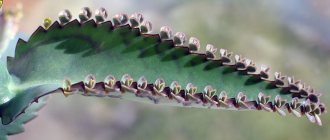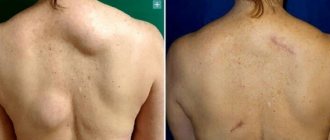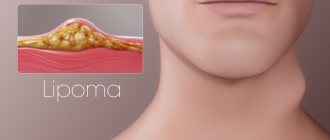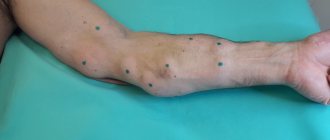The article was prepared by a specialist for informational purposes only. We urge you not to self-medicate. When the first symptoms appear, consult a doctor.
The term “fat” in everyday life usually means lipoma - a tumor of fat cells concentrated in a capsule of connective tissue. The localization of this benign formation is almost any part of the human body, but more often a lipoma occurs where there is a relatively small layer of subcutaneous fatty tissue. Wen can form on the shoulders, arms, elbows, hands, wrists and even fingers. These formations very rarely degenerate into malignant tumors, but this possibility should not be completely ruled out.
Features of wen on the hands and fingers
The appearance of any non-standard formation under the skin is a good reason to consult a doctor. Although most often the tumor turns out to be an ordinary wen, a non-specialist does not have the necessary knowledge to make an independent diagnosis. A fatty tissue is not a tumor in the usual sense; it is a connective tissue capsule filled with fat cells.
Features of wen on the hands:
- In very rare cases, lipid formations on the hands may not have a capsule; fat accumulates under the epidermis layer, penetrating deep into the muscle over time. This pathology is called diffuse lipoma;
- Wen on the hands, reaching impressive sizes, leads to impaired motor functions;
- Saturation of the hands and fingers with nerve endings, contact of the formation with the joints can lead to pain when the wen grows excessively;
- Wen on the hands are more often injured due to the specificity of their localization;
- Even a small formation on the hand is clearly visible, causing psychological discomfort to its owner.
Wen can increase in size, reaching the size of an orange or a tennis ball. The growth of the formation intensifies even more after its mechanical damage. Wen on the fingers are injured especially often, since the hands take part in hundreds of different operations during the day.
Methods for diagnosing formations on joints
When contacting a specialist, a clinical examination is initially performed. The doctor studies the symptoms and palpates the elbow or knee, determining:
- consistency (soft, dense);
- presence of pain;
- mobility of internal nodes.
If the data obtained indicates the presence of a lipoma on the knee or elbow, treatment is prescribed. If an inflammatory process or tree growth is suspected, additional diagnostics are carried out:
- X-ray excludes the possibility of fracture or dislocation;
- Ultrasound examination allows you to recognize the internal state of the joint (presence of pus) and periarticular tissues;
- cytological analysis allows you to see the shape of the formation;
- A puncture is prescribed to determine the type of bursitis based on fluid analysis.
Reasons for the appearance of wen
There are several factors, the combination of which leads to the appearance of lipid formation on the hands and fingers. However, there are no specific reasons that cause the development of this particular type of wen. Many aspects can immediately influence the formation of lipomas.
Causes of wen:
- Hereditary predisposition;
- Hypothyroidism, diabetes mellitus and other endocrine pathologies;
- Impaired functioning of the gastrointestinal tract, liver or kidneys;
- Frequent psycho-emotional disorders, stress;
- Pathological addiction to nicotine, alcohol, drugs;
- Unbalanced diet - predominance of fats and carbohydrates in the menu.
Genetically determined predisposition, diseases of the liver and endocrine glands are a common cause of lipomatosis - multiple formation of wen under the skin of the hands and fingers. In this case, the localization of tumors is not limited only to the hands; wen forms on any part of the patient’s body.
Methods for eliminating lipoma tumors
The attending physician decides how best to remove the formation. The decision is made after analyzing the medical history, taking into account the child’s age, state of health and tumor size.
The methods for removing lipoma are as follows:
- radical method using a scalpel;
- mechanical method or liposuction;
- laser method.
If the tumor is removed mechanically, using a scalpel, then this operation is good because the possibility of recurrence of the lipoma is almost completely eliminated. However, this radical method has a significant drawback. After surgery, a scar is visible on the skin. Over time it may just look like a stripe. However, it can also be quite noticeable.
Laser method. It has a lot of advantages - minimally invasive, quick recovery, less pain. The possibility of infection during surgery is practically eliminated, and the risk of bleeding is low. The scar remains unnoticeable and not rough. This operation is used to eliminate small tumors, as well as if the lipoma is located on the genitals or nipples.
The liposuction method is minimally invasive and has proven itself in good aesthetic terms. Among the disadvantages of this mechanical method is the possibility of recurrence of lipoma.
In this case, the contents of the formation capsule are drawn in with a syringe. The capsule itself remains in place. There is no need to cut the skin, so the cosmetic effect of liposuction is the best.
The duration of surgery by any method is from 30 minutes to one hour. If lipoma removal is required using a laser, then you need to carefully select a clinic. Such operations are carried out exclusively with the help of high-quality expensive equipment. Doctors must have appropriate high-level qualifications and permission to perform such operations.
Wen on fingers
At the beginning of its development, such a formation may look like a regular boil. The presence of a soft, painless mound on the finger for a long time is a reason to identify it as a wen. There is a very thin layer of epidermis and muscles on the fingers, so the lipoma does not have the opportunity to grow greatly. However, the growth of wen on the fingers leads to the fact that it begins to interfere with the functioning of the joints, touching and damaging them.
The advantage of this formation is that a wen on the fingers is easily diagnosed, especially if it grows steadily. Frequent injury to a fatty tumor forces the patient to seek medical help. Removing a large formation on a finger requires the surgeon’s exquisite work to preserve the functionality of the limb.
Fibroma
This is a benign oncological formation, which consists of connective and epithelial tissue. This tumor occurs on the skin in the deepest layer of the epidermis or in the mucous membrane of various organs. This formation can occur on any part of the body.
The development of the disease occurs gradually. At first it is a barely noticeable nodule that does not bother you and often goes unnoticed. It then progresses and turns into a small lump, and only then does it develop into a full-fledged fibroma. This is a long process that can last for years without pain.
A tumor on the finger is more common than others, but still quite rarely can be identified by pain. Pain can only occur when the fibroid reaches a relatively large size and begins to affect the nerve endings.
The skin of the finger in this regard is much more sensitive than the skin of the hand, for example.
One of the symptoms may be redness around the fibroid.
Treatment
Surgical excision is the main method. The method involves removing the tumor using a scalpel under local anesthesia. The procedure is painless.
Laser treatment. This is one of the most modern treatment methods. The doctor uses a laser to remove the tumor from the skin layer by layer. In this case, the capillaries that open when damaged are instantly sealed. This way there is no bleeding.
Wen on the palms
Separately, we should consider xanthomatosis, a metabolic disease in which multiple lumpy growths with soft, loose, yellow contents form on the palms. It is represented by a mixture of cholesterol and cholestanol. Xanthomas are localized not only on the hands, they can affect the eyelids, corners of the eyes and, in general, any parts of the body of a person suffering from a serious disorder of lipid metabolism. Treatment of xanthomatosis involves a combination of drug therapy with surgical or cosmetic removal of yellow plaques and growths on the skin.
Diagnostics
A dermatovenerologist can recognize a wen visually, by its appearance.
Differential diagnosis can also be used. It is carried out for benign or malignant formations on the skin. We mentioned earlier that occasionally wen can be malignant. Then they are called not lipomas, but liposarcomas. To verify the diagnosis, ultrasound and computed tomography are performed.
Ultrasound examination helps to see the wen as a hypoechoic formation with a capsule, which is located among the subcutaneous fat layer or between the fibers of muscle tissue. A CT scan is needed to determine the structure of the tumor. For example, it is determined how a tumor absorbs X-ray rays in comparison with the tissues located around the tumor.
Research should be carried out only in a professional medical institution with good equipment. Then the diagnosis will be the most accurate and correct.
The main misconceptions regarding the treatment of wen on the hands
Self-medication of a fatty tumor at home is very dangerous, no matter where it is and no matter what its minimum size.
There are several other misconceptions regarding the treatment of wen on the hands:
- You can get rid of wen with the help of medicinal herbs and compresses. Relieving minor symptoms with such methods is quite possible, but it will not be possible to completely cure the wen and eliminate its cause.
- Returning to a healthy lifestyle will help cure the wen. To prevent education, you can stick to a diet and give up bad habits, but the process that has begun cannot be stopped by such measures.
- There are special diets designed to get rid of fatty tumors. Body weight and the size of the wen are in no way related to each other, so losing weight will not help get rid of the problem or even stop the growth of the formation.
Opening the tumor capsule on your own will not help get rid of it, since the fragments of connective tissue remaining in the wound will become the basis for relapse.
Treatment
How to remove a wen from a child? In what ways does this happen? If necessary, only a qualified specialist can fix the problem.
There are different cases of lipoma formation and, accordingly, different treatment is provided for each of them. Let's look at typical cases of lipomas in children.
If a wen is on the face of an infant - how to get rid of it? In babies under one year of age, they look like pimples, white on the inside. Most often they can be seen on the baby's nose or on the child's eyelid. Such formation is usually provoked by a hormonal disorder and after some time disappears on its own. Under no circumstances should the integrity of this pimple be violated. It is prohibited to influence such a lipoma in any way. It cannot be squeezed out, pierced, etc.
The baby must make an appointment with a dermatovenerologist. If necessary, he will prescribe an appropriate course of treatment.
If the formation is located in the occipital region and is subcutaneous, only a surgeon can remove it. The same can be said about lipoma, which is located in the chest area. Surgery is also needed here. If the formation occurs on the chest, it is especially important to eliminate it in girls. In the future, the wen can interfere with the normal development of the mammary glands.
If a wen is detected in a child, treatment can also be conservative. This is practiced when the patient is still quite young in age, and the tumor has just appeared. This type of treatment is carried out therapeutically, using medications. May be assigned:
- special medicinal ointments;
- a special diet in which you should eat foods with a high content of fiber and nutrients.
Conservative treatment is also indicated after the tumor has been surgically removed. It can be prescribed for prophylactic purposes to avoid relapse of the tumor.
Differentiation of a wen on the arm from atheroma
A sebaceous cyst (atheroma) can have symptoms similar to a lipoma, so distinguishing these formations from each other can be very difficult.
Differentiation of wen from atheroma - main signs:
- Localization of atheroma is the sebaceous gland, localization of the wen is its own capsule of connective tissue;
- The atheroma is tightly attached to the skin and is crowned by a clogged mouth of the gland, and the lipoma moves quite freely under the epidermis;
- Pain and discomfort are frequent companions in the initial stages of atheroma development, and lipoma is painless, its main symptom is constant growth;
- The localization of atheroma is the upper layers of the epidermis, its contents can be visible outward, and the lipoma is located deeper;
- Atheroma is denser and more elastic to the touch than lipoma;
- The skin over the surface of the lipoma can be gathered into a fold, which cannot be said about a sebaceous gland cyst;
- Lipoma has a more impressive growth potential, while atheroma rarely reaches the size of a quail egg.
When treating small lipomas (up to 3 cm in diameter), it is possible to use drugs that absorb adipose tissue. Atheroma cannot be treated with such methods, especially if the cyst is inflamed.
Removal Precautions
Even with large tumors on the hand, forearm, or leg, the operation rarely ends in complications. Most patients have their sutures removed within the standard timeframe – after 7–10 days. If the lipoma is small, the scar with standard surgery will be small and barely noticeable.
Classic surgery has the lowest relapse rate. It is permissible to engage in self-medication and disposal only after consulting a specialist.
The article has been reviewed by the site editors
Is it possible to delete
The decision about whether it is necessary to remove a wen in the wrist or elbow area should be made only by a doctor. Sometimes the doctor advises not to touch the tumor at all, but only recommends observation with regular conducting of the necessary studies. This happens with small tumors that do not have a visible tendency to grow and develop and do not show any symptoms. And surgical removal is prescribed for the following manifestations:
- inflammation;
- sudden growth;
- the appearance of pain;
- change in skin color.
In other cases, the surgeon, assessing each case separately, selects the most suitable treatment method.
Under no circumstances should you remove a lipoma on your arm yourself. This action will not give the expected results and will worsen her condition. Although the wen is a benign formation, trauma can lead to reorganization into a malignant tumor.









